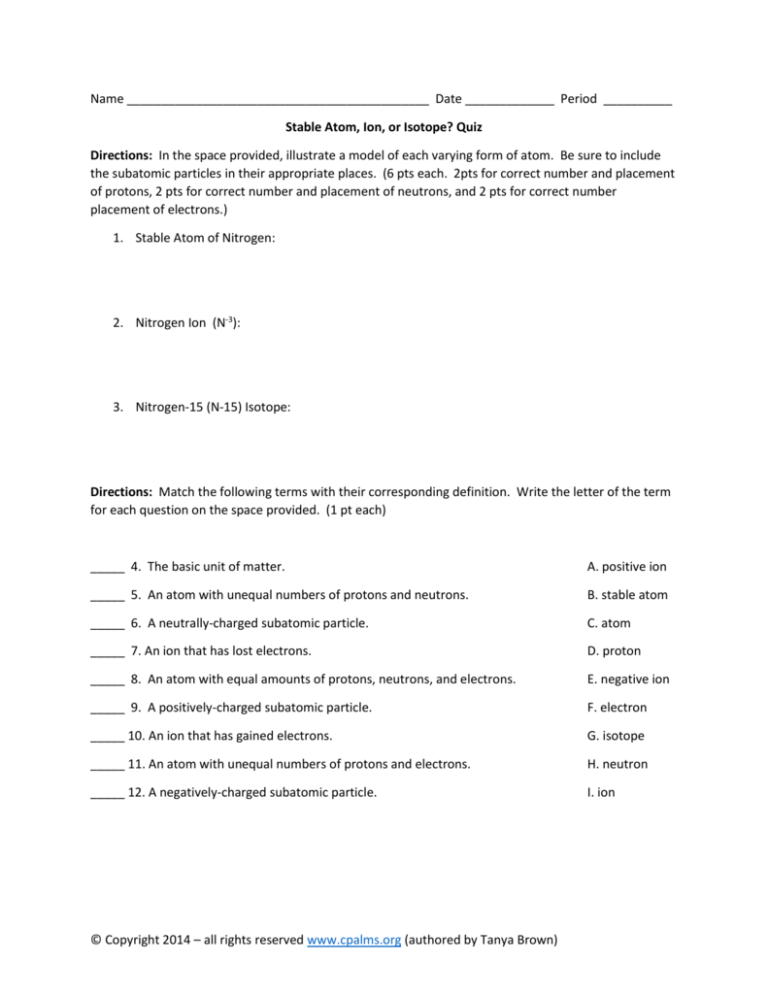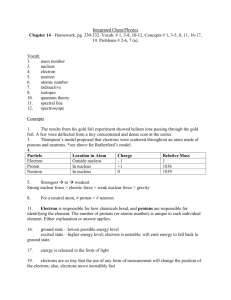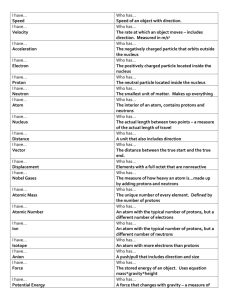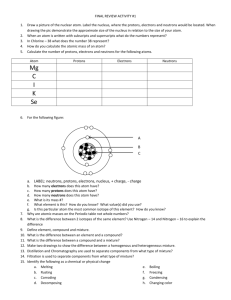
Name ____________________________________________ Date _____________ Period __________
Stable Atom, Ion, or Isotope? Quiz
Directions: In the space provided, illustrate a model of each varying form of atom. Be sure to include
the subatomic particles in their appropriate places. (6 pts each. 2pts for correct number and placement
of protons, 2 pts for correct number and placement of neutrons, and 2 pts for correct number
placement of electrons.)
1. Stable Atom of Nitrogen:
2. Nitrogen Ion (N-3):
3. Nitrogen-15 (N-15) Isotope:
Directions: Match the following terms with their corresponding definition. Write the letter of the term
for each question on the space provided. (1 pt each)
_____ 4. The basic unit of matter.
A. positive ion
_____ 5. An atom with unequal numbers of protons and neutrons.
B. stable atom
_____ 6. A neutrally-charged subatomic particle.
C. atom
_____ 7. An ion that has lost electrons.
D. proton
_____ 8. An atom with equal amounts of protons, neutrons, and electrons.
E. negative ion
_____ 9. A positively-charged subatomic particle.
F. electron
_____ 10. An ion that has gained electrons.
G. isotope
_____ 11. An atom with unequal numbers of protons and electrons.
H. neutron
_____ 12. A negatively-charged subatomic particle.
I. ion
© Copyright 2014 – all rights reserved www.cpalms.org (authored by Tanya Brown)
Directions: Answer each of the following in complete sentences. Be sure to use your vocabulary in your
explanations and remember to use your knowledge gained from the lab as a reference. (4 pts each)
13. Sometimes atoms gain or lose electrons. One atom might take an electron from another, or one
atom might lose an electron. Describe what occurs to atoms when they lose and gain electrons. (Be
specific and address both losing and gaining electrons in your response!)
14. The number of protons an atom has determines the identity of the atom. Explain why atoms lose
electrons, and not protons, during chemical bonding.
15. Describe how an atom becomes neutral.
© Copyright 2014 – all rights reserved www.cpalms.org (authored by Tanya Brown)
Answer Key:
1. The illustration should convey 7 protons and 7 neutrons in the nucleus, as well as 7 electrons outside
of the nucleus (preferably, they should be in electron clouds).
2. This illustration should convey 7 protons and 7 neutrons in the nucleus, and show 10 electrons
outside of the nucleus (preferably, they should be in electron clouds).
3. This illustration should convey 7 protons and 8 neutrons in the nucleus and show 7 electrons outside
of the nucleus (preferably, they should be in electron clouds.
4. C: atom
5. G: isotope
6. H: neutron
7. A: positive ion
8. B: stable atom
9. D: proton
10. E: negative ion
11. I: ion
12. F: electron
13. Answers will vary. The gist of their answer should be that when an atom loses electrons it becomes
positive and when it gains electrons it becomes negative.
14. Answers will vary. They should be able to discuss that the location of the electrons is a factor, that
the electron clouds surrounding the nucleus have a strong need to be full so that may be a factor, and
also could mention that the proton determines the identity of an atom so losing or gaining would
change the atom into something new.
15. An atom becomes neutral when the number of protons, neutrons, and electrons are equal,
therefore cancelling out any charges that may exist within the atom.
© Copyright 2014 – all rights reserved www.cpalms.org (authored by Tanya Brown)









